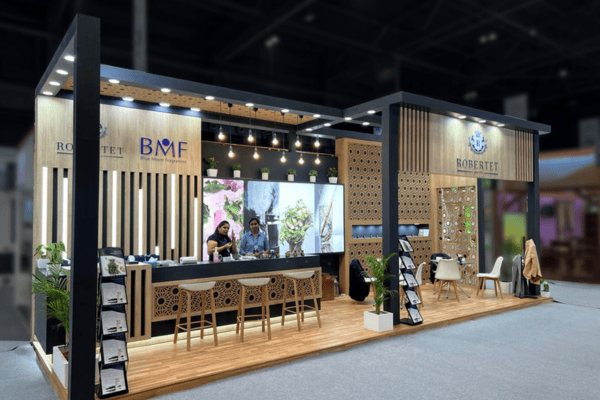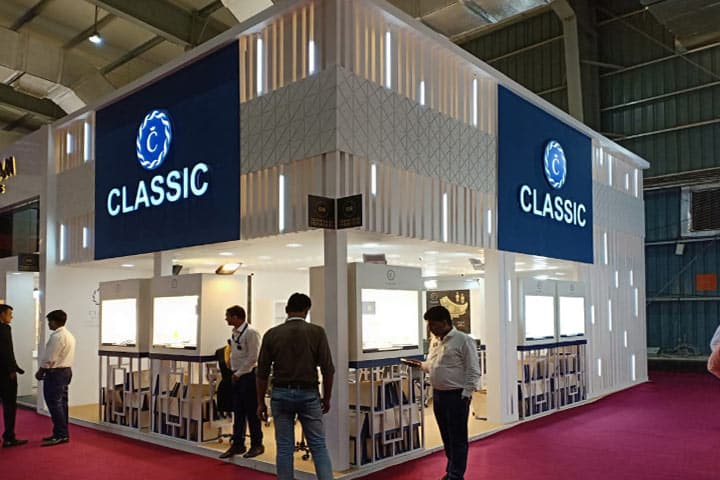Showcasing several brands inside one booth is powerful—but tricky. Without a clear plan, sub-brands get diluted, visitor journeys feel chaotic, and your main brand story disappears in the noise. This guide shows you how to brief your stall designer, structure the space, and give every brand its moment—without sacrificing cohesion.
Start with Strategy: Who’s the Hero and Why?
- Primary brand (the banner): What must visitors remember? (promise, category, tagline)
- Sub-brands: Which ones exhibit? Why now? What outcome per brand? (leads, launch, demos)
- Priority tiers: Tier 1 (hero), Tier 2 (supporting), Tier 3 (presence only)
- Messaging hierarchy: What sits outside (fascia), at approach (headline), and inside (product proofs)
Rule of thumb: One master promise on the fascia; sub-brand proof points inside.
Fascia & Identity: Be Seen, Be Clear
- Put the main brand on the fascia for distance visibility and wayfinding.
- If all sub-brands must appear on fascia, use compact lockups (grid or ticker band) beneath the master logo—never compete with it.
- Add venue-height-compliant hanging signs for long-range recognition.
Zoning That Works: 3 Proven Layout Models
1) Spoke & Hub
- Hub: Reception + master brand story.
- Spokes: Radial sub-brand pods around the hub.
- When to use: One strong parent brand with 3–6 sub-brands.
2) Boulevard (Linear Journey)
- Sequential pods along a guided path (Discover → Compare → Meet).
- Clear start/finish with soft barriers (lighting, flooring cues).
- When to use: Narrative launches or step-by-step product stories.
3) Districts (Neighborhoods)
- Distinct “districts” for categories (e.g., Diagnostics / Therapeutics / Devices).
- Shared amenities spine: storage, pantry, meeting rooms.
- When to use: Many SKUs and teams; longer dwell time.
Pro tip: Always keep entry and exit sightlines open. Avoid counters blocking the approach.
Visual System: Unite Without Making Everything Look the Same
- Parent grid: One typeface family, spacing system, and headline size across the booth.
- Color strategy: Parent brand owns structure & navigation colors; sub-brands own accent.
- Material palette: Keep structures cohesive (same laminates/frames) while letting sub-brands express via lightboxes, motion graphics, and props.
- Signal hierarchy: Big claims on high planes; details at eye level; specs at touchpoints.
Wayfinding & Visitor Flow (Psychology Meets Practicality)
- People tend to turn right on entry—place a hero sub-brand there.
- Use light temperature and floor textures to cue zones (warm = hospitality, neutral = product).
- Queue design for demos: serpentine bands prevent crowd spillover into other brands.
- Install digital totems at intersections: “You are here → Explore X / Y / Z”.
Content & Interactions (Keep It Focused)
For each sub-brand:
- 1 hook (outcome, not feature)
- 1 experience (demo, sample, AR/VR preview)
- 1 proof (case study metric, certification, testimonial)
- 1 action (scan QR, book demo, talk to specialist)
If using AR/VR, confirm organizer policies and audience comfort; not every expo allows or expects it.
Governance & Collateral Control
- Create a content matrix: who owns copy, visuals, approvals for each brand.
- Enforce a “no ad-hoc banner” rule on-site. Last-minute printouts kill cohesion.
- Centralize assets (logos, claims, disclaimers) with version control.
Seating, Storage, and Shared Services
- Shared meeting rooms (neutral design) to avoid “territorial” clashes.
- Brand-specific kiosks for leaflets/samples; central storage for bulk.
- Pantry and hospitality are brand-agnostic (keeps service consistent).
Compliance, Safety & Mezzanine Notes
- If planning double-decker (mezzanine): obtain organizer approvals well in advance.
- Respect venue height/load limits—especially in pharma halls.
- Ensure dual egress and fire-retardant materials; keep escape routes unobstructed.
KPIs & Lead Routing (Avoid Post-Show Confusion)
- Badge scanners or QR forms must tag the sub-brand automatically.
- Map lead ownership (who follows up what) before the show.
- Daily pod retrospective (15 min): what to tweak in flow, content, staffing tomorrow.
Common Pitfalls (and Fixes)
- Everything on the fascia → Visual noise.
Fix: Master brand headline outside; sub-brand stories inside. - Clashing color worlds → Fatigue/confusion.
Fix: One structural palette; sub-brand accents only. - Competing sound/video → Cognitive overload.
Fix: Stagger loops; use directional audio; cap decibels. - Storage bleeding into view → Messy perception.
Fix: Built-in lockable credenzas per pod + central back-of-house.
Your Multi-Brand Brief: Copy-Paste Checklist
- Master brand promise, tagline, key claims
- Sub-brands list + priority tiers (T1/T2/T3) + goals
- Layout model (Spoke & Hub / Boulevard / Districts)
- Fascia plan (what’s on fascia, what’s not)
- Visual system (grid, fonts, colors, material palette)
- Zone map with pod sizes & adjacencies
- Interactions per sub-brand (demo/AR/VR/samples)
- Proofs per sub-brand (case metrics, certs, testimonials)
- Seating plan (open lounge, bar, meeting rooms)
- Storage/pantry plan (per pod + central)
- AV plan (screen sizes, audio policy, loop durations)
- Compliance (fire-retardant, electrical load, rigging, mezzanine approvals)
- Lead capture taxonomy (brand tags), CRM routing, daily huddles
- Build timeline (pre-build mock, dispatch, on-site I&D windows)
About FirstRain Exhibits
FirstRain Exhibits is a premium exhibition stall design, fabrication, and on-ground execution partner. We specialize in complex multi-brand booths that balance clarity, cohesion, and conversion—from strategy and zoning to content, compliance, and finish.
Where we operate: Mumbai, New Delhi, Greater Noida, Bengaluru, Hyderabad, and Chennai.
Ready to plan a multi-brand pavilion that actually works?
Get a free zoning concept + fascia plan tailored to your brand architecture.






